| dc.description.abstract | There is hardly any doubt that climate plays a significant role in shaping the face of the earth and in determining the type of economic activities that man may practice. The realization of the man climate relationship has led to growing interest in the science of climatology especially in the tropical areas where the controls exerted by the various climate factors, such as the annual rainfall and temperature, are really vital and effective.
The agriculture was considering the dominant sector in GDP of Sudan because by 1956 it accounted about 60% of the total GDP while whole the other sectors contributed about 40% of gross domestic production (Work Bank, 2003). Approximately 80% of the labor force of Sudan‟s population is employed in agriculture and related activities. Rain fed agriculture in Sudan is affected by drought and variation in seasonal rainfall amounts during the last decade and climate change impacts have been reported in many areas of the country. Gadaref area is considered one of the most important rain-fed agricultural areas in Sudan, and it contributes more than 40% of the rain-fed cereals produced in the country. The objective of this study is to assess the impact of climate variability and change on sorghum yield over Gadaref area in Sudan using AquaCrop model.
The trend analysis results show the maximum temperature and minimum temperature have significant trend (increasing trend) over the study area, implying that the temperature was been increasing over study area during the last decade. While the rainfall has an insignificant trend (decreasing trend) over the study area, indicating there was no significant change in rainfall during the last decade over the study area.
Maximum and minimum temperature showed a negative relationship with correlation coefficients of -0.34 and -0.31 with sorghum respectively. This implies that an increase in temperature beyond the optimum level (high temperature of about 26-30°C and low temperature of about 10-15°C) results in a decline in sorghum production and vice versa. On the other hand Correlation analysis showed a positive relationship between sorghum and rainfall (0.59) and sorghum and evapotranspiration (0.25). This means that an increase in rainfall enhances sorghum production; while its decrease results in poor sorghum yield.
Monthly results of coefficient of variation values indicated an increase in climate variability, which was shown by larger season to season fluctuations, with a higher coefficient of variation implying less predictability in the climate.
The result of analysis of multiple regressions showed a significant (30%) relationship between sorghum and the set of climatic factors used in study. It was observed that 30% of the variability in sorghum yield could be explained by these climatic factors (rainfall, maximum temperature, minimum temperature and evapotranspiration) and was significant at (p=0.02).
The impacts of changes in climate parameters; annual rainfall and temperature, was determined by using comparisons between the observed data (past and present) and projected data (Ncc Cordex Model).Climate variability results analysis revealed significant increase in minimum temperature of 11.2% (2.39 °C) by 2046, while rainfall was projected to decrease by 33% (202.46 mm) over Gadaref area during the same period.
The results of the study using AquaCrop model showed that by 2046, the Gadaref area‟s seasonal rainfall (June-September) decline by 233.6 mm (42%), would result in average sorghum yield decrease of 39.9%. while the seasonal temperature have significant impacts in sorghum yield, This is because there was projected increase in minimum and maximum temperature by 2.24°C (6.3%) and 2.48°C (10.2%) respectively. This implies that sorghum yield production will be very sensitive to reduction in rainfall and increase of temperature during the season over study area. | en_US |



